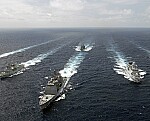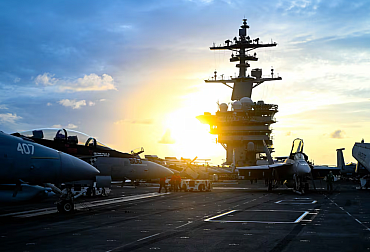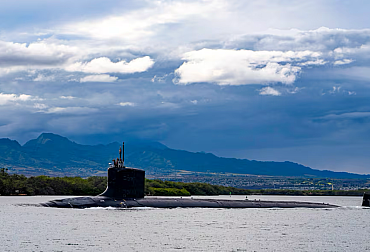China confirms plans to build its fourth aircraft carrier. Inspired by the USS Gerald Ford
Currently equipped with two aircraft carriers in STOBAR configuration, the Indian Navy hopes to obtain a third, based on the INS Vikrant model, the first national design. As for the People's Liberation Army navy, it is in the process of building up significant naval aviation capabilities at a rapid pace.
After refitting the former Varyag aircraft carrier under the name Liaoning, acquired from Ukraine for 20 million Euros in 2000, China built its sister named Shandong. The issue with this conception of carriers is that the air operations they can carry out lack flexibility, as the fuel and ammunition carrying capacity of their onboard combat aircraft is limited, especially when compared to what modern construction of aircraft carriers offers. In addition, they are unable to deploy airborne surveillance aircraft, and this essential function is, in their case, being performed by slow helicopters with limited range, offering a detection capability of around 200 km, when comparted to the larger fixed wing alternatives.
These limitations combined, together with the conventional propulsion systems, mean that these two ships rarely venture beyond the China Sea. The Chinese navy also undoubtedly still has some way to go when it comes to protecting a naval air group, particularly in the area of underwater warfare. On the other hand, China's naval air capabilities undoubtely continue to grow at a steady pace. In June 2022, China launched its third aircraft carrier, the Fujian, which, unlike its two predecessors, is in CATOBAR configuration, equipped with electromagnetic catapults and arresting cables. At the same time, the Chinese Navy has launched the development of the KJ-600, an aerial surveillance aircraft, as well as a naval version of the 5th generation J-35 fighter-bomber.
KJ-600 surveillance aircraft
The Xi'an KJ-600 is a military aircraft configured for cargo and airborne early warning and control (AEW&C), intended for deployment on the People's Liberation Army's Type 003 aircraft carriers. The KJ-600 is to be powered by a pair of WJ-6 turboprop engines and features a large dorsal radome equipped with a one-sided array AESA-type radar system, based on only half of the rotodome having dielectric coverage. The similarities with the Northrop Grumman E-2 'Hawkeye' are obvious. The first KJ-600 made its maiden flight at the end of August 2020, even though the company has never officially confirmed this. The aircraft features a top radome similar to China's previous KJ-2000 and KJ-500 early warning aircraft.

Based on the configuration of the KJ-600, it is clear that the aircraft cannot be used on China's first two current aircraft carriers, which are not equiped with catapult. The third Chinese aircraft carrier is expected to use an EMALS-type electromagnetic catapult and will be compatible with the KJ-600. We can assume that the KJ-600 will equip the Fujian, as well as the Type 004 currently in preparation. The KJ-600 will become distant eyes and considerably increase the overall combat capability of Chinese aircraft carriers, which currently only have helicopters for early warning purposes. With the KJ-600, the Chinese Navy’s detenction capability should cover a range of 400 to 500 km.
J-35 fighter-bomber aircraft
The J-35 model is the third evolution in the design of the FC-31 (originally called the J-31), China's second stealth fighter, the first prototype of which flew in October 2012. That first prototype also had a design very reminiscent of the American F-22 and the F-35, something that was modified in the second version, which made its maiden flight in December 2016. The J-35 will be one of the aircraft in the air group embarked from China's new aircraft carrier, the Fujian, launched in June 2023. The aircraft will operate alongside the famous J-15 Flying Shark, a copy of the Russian Su-33, and the aforementioned KJ-600. Currently, only the US Navy and Royal Navy operate stealth fighters on their aircraft carriers, in the form of the F-35C Lightning II, as well as the F-35B VSTOL, used on the British carriers and generally on amphibious landing craft.
The Fujian and Type 004
With a displacement of 80,000 tonnes and a length of 320 metres, the Fujian will be the largest ship in the Chinese Navy. But unlike its French and American counterparts, its propulsion will not be nuclear. After testing its three catapults last November, it should not be long before it begins sea trials. However, for the Chinese, having three aircraft carriers is not enough, given that a ship of this type spends a third of its time in maintenance, a third in training and a third in operations. So having three means that the Chinese Navy can only have one aircraft carrier at any given time.
It should be noted that only the Shandong is currently operational, the Liaoning having just returned to sea, carrying a scale model of the J-35 on its flight deck, after having been immobilised for a year for maintenance operations. Hence the announcement, which came as no real surprise, by Admiral Yuan Huazhi, the People's Liberation Army’s Political Commissioner for the Navy, on the sidelines of the 2nd session of the 14th National People's Congress on 6 March. China will "soon build its fourth aircraft carrier and answer the question of whether it will be nuclear-powered. We build aircraft carriers to protect our national sovereignty and territorial integrity," said Admiral Yuan, adding that they should also "sail further away from Chinese coastal waters."
As to whether China could cope with American aircraft carriers, Admiral Yuan was categorical: "Trust us, we can. We don't just deal with aircraft carriers. We also deal with potential threats globally," he replied. Last year, the Jiangnan Changxing shipyard unveiled a project for a new aircraft carrier that might correspond to the one mentioned by the PLA Navy Political Commissioner. In principle, it was inspired by the USS Gerald Ford and the French project for a new generation aircraft carrier, the PANG, with an island located aft of the flight deck.








